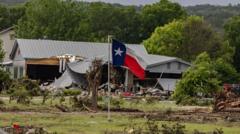As temperatures rise due to climate change, the conditions for extreme rainfall events have become more prevalent globally, with Texas experiencing some of the most significant impacts. Known for its fluctuating weather, Texas faces a heightened risk of misuse of increasingly intense rainfall, leading to tragic flooding incidents.
Extreme Rain Events Intensified by Climate Change Threaten Texas and Beyond

Extreme Rain Events Intensified by Climate Change Threaten Texas and Beyond
The increase in severe rainfall patterns linked to global warming poses new threats to Texas, exposing vulnerabilities in infrastructure and emergency systems.
In Central Texas, home to the notorious “flash flood alley,” recent events have underscored the severity of the situation. Warm air holding more moisture leads to heavy downpours when it interacts with cooler air, an issue compounded by aging infrastructure and insufficient warning systems. An alarming incident occurred when the Guadalupe River surged from three feet to 34 feet in merely 90 minutes, evidencing the sometimes overwhelming power of nature exacerbated by climate change.
Russ Schumacher, a professor of atmospheric science at Colorado State University, revealed that areas experiencing rainfall during a tragic storm had less than a 0.1% likelihood of such deluges occurring in a typical year. As intense storms become the norm, regions like Texas must reevaluate their preparedness and resilience against these natural disasters.
Local officials emphasize the urgent need for improved infrastructure and better warning systems to mitigate the impacts of such extreme weather events. Assistant emergency managers are working tirelessly to adapt and respond to these changing conditions, yet the stakes are rising, highlighting the critical intersection of climate change and human safety.
The events in Texas serve as a stark reminder of the need to address climate change effectively and build resiliency in communities vulnerable to increasingly frequent and violent weather patterns. As the planet continues to warm, proactive steps are essential to safeguard lives and infrastructure from what may become an all-too-common occurrence.
Russ Schumacher, a professor of atmospheric science at Colorado State University, revealed that areas experiencing rainfall during a tragic storm had less than a 0.1% likelihood of such deluges occurring in a typical year. As intense storms become the norm, regions like Texas must reevaluate their preparedness and resilience against these natural disasters.
Local officials emphasize the urgent need for improved infrastructure and better warning systems to mitigate the impacts of such extreme weather events. Assistant emergency managers are working tirelessly to adapt and respond to these changing conditions, yet the stakes are rising, highlighting the critical intersection of climate change and human safety.
The events in Texas serve as a stark reminder of the need to address climate change effectively and build resiliency in communities vulnerable to increasingly frequent and violent weather patterns. As the planet continues to warm, proactive steps are essential to safeguard lives and infrastructure from what may become an all-too-common occurrence.




















